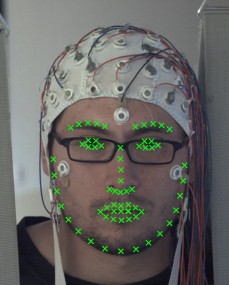- October 2014: Periodic and final reports for the qFATIGUE European
Re-integration Grant were prepared and submitted to the European
Comission.
- September 2014: official end of the qFATIGUE
project. However, we will continue working on several activities that
were started during the project.
- September 2014: M. Divjak participated at the ICDVRAT conference in Goteborg, Sweden.

- August
2014: Eye blink detection by using Deep Neural Networks - here are some
preliminary results on our new dataset (8000 images for training, 2700
images for testing):
Final stats accross all iterations:
- TP rate (sensitivity) = 0.97957
- TN rate (specificity) = 0.9387
- FP rate = 0.061304
- FN rate = 0.020435
- accuracy = 0.95913 - August 2014: M. Divjak participated at the ICHMI conference in Zürich, Switzerland.
- June 2014: Example of fatigue effects visible in EEG power spectrum of one selected person:
Blue line: 2 minutes at the beginning of training session, non-fatigued.
Red line: 2 minutes at the end of training session, fatigued.
Data shown is for upper alpha frequency band and F3 frontal cortical region.
Both Kruskal-Wallis and ANOVA statistical tests showed significant difference between the two signals.
- March 2014: M. Divjak participated at the ROSUS conference in Maribor, Slovenia.
- February 2014: M. Divjak participated at the ROS Summer School, organized in the framework of the joint slovenian-austrian EFRE project TEDUSAR.
- July
2013: New face model based on Constrained Local Models: detected facial
feature points are marked with green crosses. The CLM model performs
well and is faster than AAM. All existing video-based fatigue metrics
were upgraded with support for such CLM models.

- April 2013: Mid-term report for the qFATIGUE European Re-integration Grant was submitted to the European Comission.
- April
2013: Core algorithms for monocular 3D scene reconstruction have been
developed and validated in the laboratory (see example below). More tests are needed on
real-world videos from the field robot.


Matched features between two video frames. 3D point cloud of the reconstructed structures. - February 2013: A new program for automatic selection of representative AAM training images from video was developed.
- November 2012: Start of work on 3D scene reconstruction
from monocular video camera (Structure-from-motion),
for online creation of 3D models. This task is part of cooperation with
Dr. Jurij Rakun from Faculty
of Agriculture and Life Sciences in Maribor.
- September 2012: Person-specific AAM models developed and tested for
eye blink detection. The following images show how the model adapts to
eye movements, even in difficult cases where left and right eye
movements are not symmetric and the eye is partially obscured by
glasses:




- July 2012: Manual annotation of eyeblink intervals in the
video dataset is finished.
- May 2012: Tilen Bobek successfully presented his Bachelor
thesis entitled Video
Tracking of Human Faces which was prepared under mentorship
of Dr. Damjan Zazula and Dr. Matjaž Divjak.
- February 2012: We started with manual annotation of
eyeblinks using the video dataset captured at the end of project
PRE-WORK (our preceeding Marie-Curie project).
- January 2012: A new appearance model for extraction of eye
and its features from high-resolution images was prepared.
- November 2011: Matjaž Divjak visited VISION 2011 in Stuttgart, the largest european trade fair for Machine Vision.
Planned project activities:
- A1: Project management
- A2: Requirements study
- A3: Vision-based fatigue detection software
- A4: EEG-based fatigue detection software
- A5: Merging of EEG-based and vision-based data into a joint mental fatigue model
- A6: Acquisition & analysis of experimental data
- A7: Dissemination and exploitation



